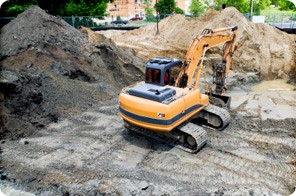 In-situ remediation is an emerging technology that utilizes various methods to remediate soil and groundwater in place or on the site, thus reducing costs and liabilities associated with removal, transportation, and off-site disposal at a licensed facility. Soil and groundwater contaminated with hazardous substances and or petroleum products can be remediated in place or within a treatment cell on site using microbes, surfactants, and non-toxic surfactants and nutrients.
In-situ remediation is an emerging technology that utilizes various methods to remediate soil and groundwater in place or on the site, thus reducing costs and liabilities associated with removal, transportation, and off-site disposal at a licensed facility. Soil and groundwater contaminated with hazardous substances and or petroleum products can be remediated in place or within a treatment cell on site using microbes, surfactants, and non-toxic surfactants and nutrients.
In-situ Surface Spill Microbial and Chemical Treatment
Physical/chemical treatment uses the physical and/or chemical properties of the contaminants or of the contaminated medium in concert with solutions containing micro-organisms, non-toxic surfactants and nutrients to destroy, separate, or contain the contamination. In the physical processes the phase transfer of pollutants is induced. In the chemical processes the chemical structure (and then the behavior) of the pollutants is changed by means of chemical reactions to produce less toxic or better separable compounds from the soil and groundwater matrices. CRG Texas completed the in-situ remediation of oil & gas produced water (salt water) and crude oil impacted soil at 7 areas totaling over 35 acres at a ranch in south Texas. A “No Further Action” letter was received from the Railroad Commission of Texas within 6 months from the date of Notice to Proceed from the client.
In-situ Surfactants and Microbial Underground Fuel and Chemical Tank Pit Flushing
In-situ surfactant flushing has been used at NAPL-contaminated sites to demonstrate the capability of in situ surfactant flushing for cleaning-up the contaminated “hot” source zone. In-situ soil washing and tank pit flushing is performed using injection and extraction wells to circulate microbial and compound release chemicals within the affected zones, thus expediting recovery of toxic chemicals directly from the source of the pollution. CRG Texas performed in-situ tank-hold flushing for a diesel fuel release at an active fleet fueling facility. CRG Texas was able to reduce the fuel thickness within the tank hold, complete the additional assessment work with no interruptions to the facility’s operations, and received a “No Further Action” determination from the Texas Commission on Environmental Quality (TCEQ).
In-Situ Chemical Oxidant Injection- Subsurface Soil and Groundwater
Spills and leaks of chlorinated solvents to soil and shallow groundwater poses a serious threat also to vapor intrusion at the surface to deeper drinking water aquifers. Commonly these contaminants are present in the subsurface in the form of non-aqueous phase liquids (NAPL), as dissolved contaminants in ground water, and as vapors in the soil that could migrate to the surface and into buildings. Because the density of NAPL’s is greater than water (specific gravity greater than 1), they tend to sink in ground water bearing units, which results in a complex dispersal and plume patterns, and in long- term sources in the subsurface, and making clean-up more challenging. In situ chemical oxidation (ISCO), is a form of advanced advanced oxidation technology and processes, and is an environmental remediation technique used for soil and/or groundwater remediation to reduce the concentrations of targeted environmental contaminants to acceptable levels. ISCO is accomplished by injecting or treating strong chemical oxidizers directly into the contaminated medium (soil or groundwater) to destroy chemical contaminants in place. It can be used to remediate a variety of organic compounds, including some that are resistant to natural degradation. CRG Texas has employed in-situ oxidant injection to expedite regulatory agency case closures at various soil and groundwater remediation sites in Texas. When compared to traditional remediation methods, In-situ chemical oxidant injections can save the client time and money.
In- Situ Remediation Tips
Be sure to establish and employ best management practices to reduce the likelihood of environmental impacts to your facility. From standard operating procedures for waste minimization and management, to stormwater, air, and accidental discharges during day to day operations, confirm environmental regulations and company policies are followed from top management down.
